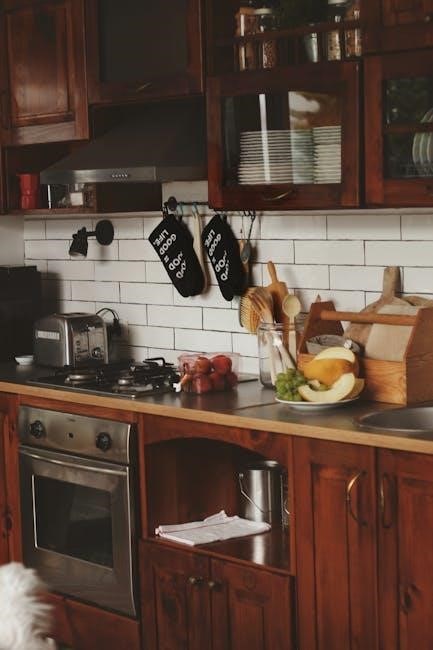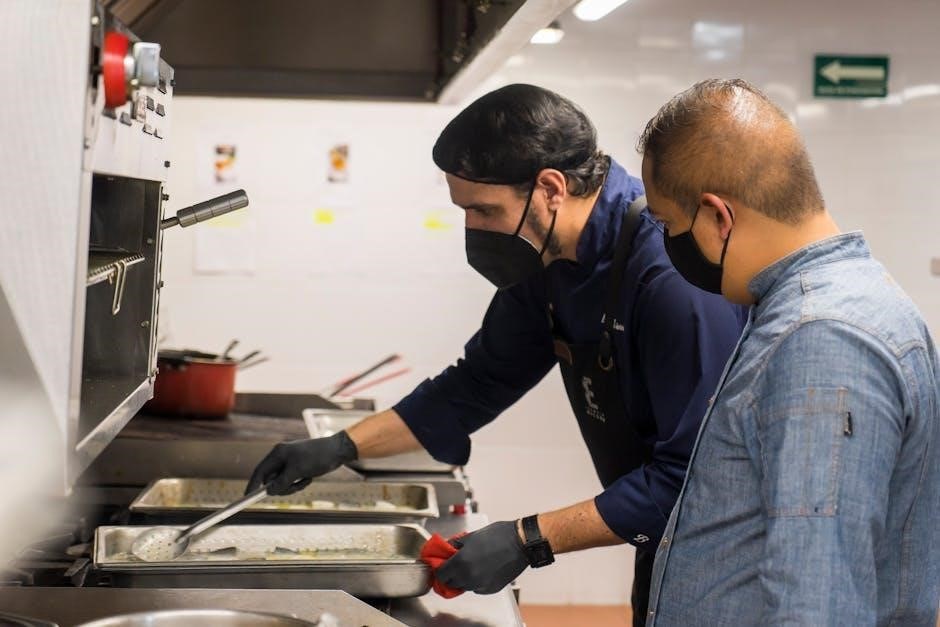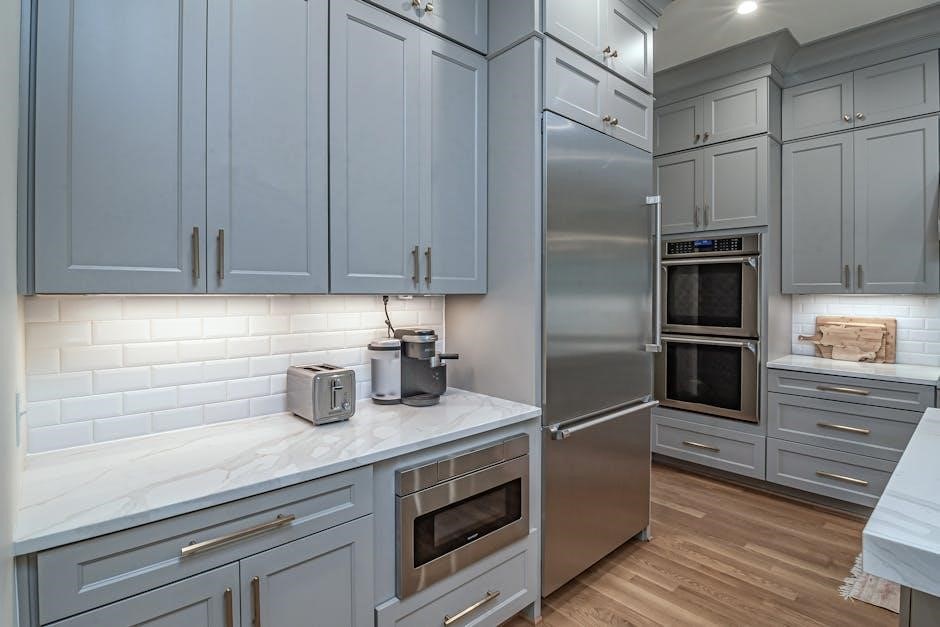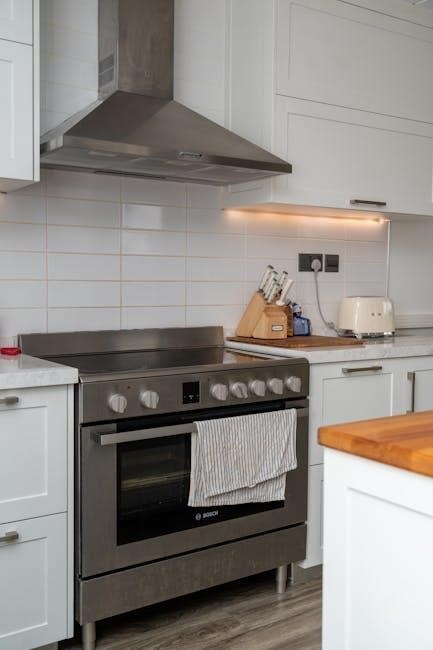
oster toaster oven instruction manual
Welcome to the world of Oster toaster ovens! This guide is designed to help you locate and utilize your Oster toaster oven instruction manual․
These manuals are essential for understanding your oven’s features, safe operation, and maintenance procedures․

Finding Your Oster Toaster Oven Manual
Locating the correct instruction manual for your Oster toaster oven is the first step to ensuring its proper and safe use․
Several avenues can be explored to find the specific manual corresponding to your model․
Firstly, check the product packaging or any accompanying documents that came with the toaster oven upon purchase․
Often, the manual is included as a printed booklet․
If you no longer have the original packaging, the next best place to look is directly on the Oster website․
Navigate to the support or customer service section, where you can typically find a database of manuals available for download․
You will likely need the model number of your toaster oven, which is usually located on a sticker at the back or bottom of the appliance․
Enter this model number into the search bar on the Oster website to find the corresponding manual․
Additionally, third-party websites specializing in appliance manuals can be a helpful resource․
These sites often host a wide range of manuals for various Oster models․
However, it’s crucial to ensure the website is reputable and the manual you download is indeed the correct one for your toaster oven․
Finally, if you are still unable to find the manual, consider contacting Oster’s customer support directly․
They may be able to provide you with a digital copy or guide you to the appropriate resource․
Downloading the PDF Manual
Once you have located the correct instruction manual for your Oster toaster oven, the next step is to download it in PDF format․
This format allows for easy access and viewing on various devices, including computers, tablets, and smartphones․
Typically, the Oster website and other online manual repositories offer the manual as a downloadable PDF file․
To initiate the download, simply click on the designated download link or button associated with the manual․
Before clicking, double-check that the manual corresponds to your specific Oster toaster oven model to avoid any confusion or incorrect information․
After clicking the download link, your web browser will prompt you to save the file to a location on your device․
Choose a memorable folder, such as “Downloads” or a dedicated “Appliance Manuals” folder, for easy retrieval later․
The download speed will depend on your internet connection and the file size of the manual․
Once the download is complete, navigate to the folder where you saved the PDF file․
You will need a PDF reader program, such as Adobe Acrobat Reader, to open and view the manual․
Most computers come with a PDF reader pre-installed, but if not, you can download one for free from the Adobe website․
After opening the PDF manual, you can browse through its pages, search for specific topics, and even print it out for a hard copy if desired․
Keep the downloaded PDF manual readily accessible on your device for future reference whenever you need guidance on operating, maintaining, or troubleshooting your Oster toaster oven․
It is also a good practice to back up the file to a cloud storage service or external hard drive to prevent data loss․

Oster Toaster Oven Features (Based on Manuals)
Oster toaster oven manuals detail a variety of features designed to enhance cooking convenience and versatility․
These features often vary by model, but common elements include multiple cooking functions, such as baking, broiling, toasting, and convection․
The function selector knob allows users to easily switch between these different cooking modes, catering to diverse culinary needs․
Temperature control is another crucial feature, enabling precise heat settings for optimal cooking results․
A timer control knob, often accompanied by a bell signal, provides accurate cooking time management and alerts users when the cooking cycle is complete․
Removable crumb trays simplify cleaning by collecting food debris and crumbs, preventing them from accumulating inside the oven․
Many models also feature removable wire racks that can be positioned at different levels to accommodate various food sizes and types․
Viewing windows allow users to monitor the cooking process without opening the oven door, preserving heat and ensuring even cooking․
Some Oster toaster ovens boast continuous clean interiors, which are designed to resist stains and simplify cleaning;
Cool-touch side handles enhance safety by preventing burns during operation․
Digital displays and controls are present in some models, offering precise temperature and time settings․
Convection technology, available in select models, circulates hot air for faster and more even cooking․
Preheat functions ensure the oven reaches the desired temperature before cooking begins, optimizing cooking performance․
Specific models may also include specialized features like pizza settings, defrost functions, and keep-warm settings․
Consult your specific Oster toaster oven manual for a comprehensive list of features and their respective functions․

Function Selector Knob
The function selector knob is a central control on your Oster toaster oven, dictating the oven’s operational mode․
Understanding its function is crucial for effectively using your appliance․
Typically, this knob allows you to choose between various cooking functions, each designed for specific culinary tasks․
Common settings include “Bake,” which utilizes both top and bottom heating elements for general cooking and baking; “Broil,” which activates the top heating element for direct, high-heat cooking, ideal for browning and melting; and “Toast,” specifically designed for toasting bread and other items․
Some models also offer a “Convection Bake” setting, which uses a fan to circulate hot air, ensuring even cooking and faster results․
Additionally, there might be a “Warm” or “Keep Warm” setting to maintain food temperature after cooking․
The “Pizza” setting, found on some models, optimizes the oven for cooking pizzas, providing even heat distribution․
To use the function selector knob, simply turn it to the desired setting․
Ensure the knob is firmly positioned in the chosen setting to activate the corresponding function․
Refer to your Oster toaster oven’s instruction manual for a detailed explanation of each setting and its recommended uses․
Incorrectly setting the function selector knob can lead to improper cooking or damage to the oven․
Always double-check the selected function before starting the cooking process․
The function selector knob works in conjunction with the temperature and timer controls to achieve the desired cooking outcome․
Regularly cleaning around the function selector knob will prevent buildup and ensure smooth operation․
By mastering the function selector knob, you can unlock the full potential of your Oster toaster oven and enjoy a wide range of cooking possibilities․
Temperature Control Knob
The temperature control knob is a vital component of your Oster toaster oven, allowing you to set the desired cooking temperature for various recipes․
This knob typically features a range of temperatures, usually measured in degrees Fahrenheit or Celsius, enabling precise control over the heating process․
Understanding how to use the temperature control knob is crucial for achieving optimal cooking results․
When using your Oster toaster oven, refer to your recipe for the recommended cooking temperature․
Then, turn the temperature control knob to align with the indicated temperature setting․
It’s essential to preheat the oven to the set temperature before placing food inside, ensuring even cooking․
The preheating time may vary depending on the desired temperature and the oven model․
Some Oster toaster ovens have a preheat indicator light that illuminates when the oven has reached the set temperature․
If your oven doesn’t have an indicator light, allow a few minutes for preheating before adding food․
Be cautious when setting higher temperatures, as they can cause food to burn if not monitored closely․
Conversely, lower temperatures may require longer cooking times․
The temperature control knob works in conjunction with the function selector and timer controls to provide complete control over the cooking process․
Regularly check the temperature setting to ensure it remains accurate throughout the cooking cycle․
If you notice any inconsistencies in cooking, the temperature control knob may need calibration or professional servicing․
Always unplug the toaster oven and allow it to cool completely before attempting any cleaning or maintenance․
Avoid using abrasive cleaners or scouring pads on the temperature control knob, as they can damage the surface and markings․
With proper use and care, the temperature control knob will provide years of reliable performance, enabling you to create delicious meals with your Oster toaster oven․

Timer Control Knob with Bell Signal

The timer control knob with bell signal is an essential feature of your Oster toaster oven, providing precise control over cooking time and an audible alert when the set time has elapsed․
This knob allows you to set the desired cooking duration, typically in minutes, ensuring accurate and consistent results for various recipes․
Understanding how to use the timer control knob is crucial for preventing overcooking or undercooking your food․
To use the timer, simply turn the knob to the desired cooking time;
The timer starts counting down immediately after being set․
Some Oster toaster ovens have a “stay-on” or “manual” setting, which bypasses the timer and allows the oven to operate continuously until manually turned off․
Be cautious when using the “stay-on” setting, as it can easily lead to overcooking or burning if not monitored closely․
The bell signal provides an audible alert when the set time has expired, notifying you that your food is ready․
The bell helps prevent food from being left in the oven for too long, which can result in dryness or burning․
The timer control knob works in conjunction with the function selector and temperature control knobs to provide complete control over the cooking process․
When toasting, the timer control knob determines the level of darkness or browning․
For baking and broiling, it ensures that food is cooked for the appropriate duration․
If you notice any inconsistencies in timing, the timer control knob may need calibration or professional servicing․
Regularly check the timer setting to ensure it remains accurate throughout the cooking cycle․
Always unplug the toaster oven and allow it to cool completely before attempting any cleaning or maintenance․
Avoid using excessive force when turning the timer control knob, as this can damage the mechanism․
With proper use and care, the timer control knob with bell signal will provide years of reliable performance, helping you create perfectly cooked meals with your Oster toaster oven․

Removable Crumb Tray
The removable crumb tray is a vital component of your Oster toaster oven, designed to collect crumbs and food debris that accumulate during cooking․
This feature simplifies cleaning and helps maintain the oven’s cleanliness, preventing potential fire hazards and ensuring optimal performance․
The crumb tray is typically located at the bottom of the oven and can be easily slid out for emptying․
Regularly emptying the crumb tray is essential for preventing the buildup of crumbs, which can burn and produce unpleasant odors․
To remove the crumb tray, simply slide it out from its designated slot․
Dispose of the collected crumbs in a trash receptacle․
Wash the crumb tray with warm, soapy water and a non-abrasive sponge or cloth․
Rinse thoroughly and dry completely before reinserting it into the oven․
Never operate the toaster oven without the crumb tray in place, as this can allow crumbs to fall onto the heating elements and cause a fire․
If the crumb tray becomes heavily soiled or stained, you can soak it in warm, soapy water for several minutes to loosen the debris before washing․

Avoid using harsh chemicals or abrasive cleaners on the crumb tray, as these can damage the finish․
Check the crumb tray regularly for any signs of damage or wear․
If you notice any cracks or holes, replace the tray immediately to prevent crumbs from falling into the oven’s interior․
The removable crumb tray contributes to the overall hygiene and safety of your Oster toaster oven․
By keeping it clean and in good condition, you can ensure that your oven operates efficiently and safely for years to come․
Regular maintenance of the crumb tray helps prolong the life of your toaster oven and maintain its performance․
Cleaning Your Oster Toaster Oven
Maintaining a clean Oster toaster oven is crucial for both its performance and longevity․
Regular cleaning prevents the buildup of food particles and grease, which can lead to unpleasant odors, smoke, and even potential fire hazards․
Before you begin cleaning, always ensure that the toaster oven is unplugged from the power outlet and completely cooled down․
This is essential for your safety and to prevent any electrical shock or burns․
Start by removing the crumb tray, wire rack, and any other removable accessories from the oven․
Wash these items separately with warm, soapy water and a non-abrasive sponge or cloth․
For the interior of the toaster oven, use a damp cloth or sponge to wipe down the walls, floor, and ceiling․
Avoid using abrasive cleaners, scouring pads, or steel wool, as these can scratch or damage the interior surfaces․
For stubborn stains or baked-on food particles, you can create a paste of baking soda and water․
Apply the paste to the affected areas and let it sit for a few minutes before wiping it away with a damp cloth․
Be sure to rinse thoroughly to remove any residue․
For the exterior of the toaster oven, use a damp cloth to wipe down the surfaces․
You can also use a mild dish soap solution for tougher stains․
Avoid getting water or cleaning solutions into the vents or electrical components of the oven․
Once you have cleaned all the interior and exterior surfaces, dry everything thoroughly with a clean cloth․
Reassemble the toaster oven by placing the wire rack and crumb tray back in their designated positions․
Regular cleaning, ideally after each use, will help keep your Oster toaster oven in top condition․
This ensures optimal performance, prevents odors, and extends the lifespan of your appliance․
Cooling Down and Unplugging
Prior to undertaking any cleaning or maintenance procedures on your Oster toaster oven, ensuring it is both completely cooled down and safely unplugged from the power source is paramount․
This precautionary measure is not merely a suggestion, but a fundamental safety requirement designed to protect you from potential burns and electrical hazards․
Allowing the toaster oven to cool down completely is crucial because the heating elements and interior surfaces can retain significant heat even after the appliance has been switched off․
Touching these hot surfaces can result in severe burns, so it is essential to exercise patience and wait for the oven to reach a safe temperature․
The cooling process typically takes around 30 to 60 minutes, depending on the duration and temperature of the previous cooking cycle․
To expedite the cooling process, you can open the oven door slightly, allowing heat to dissipate more quickly․
However, ensure that the oven is placed in a safe location away from flammable materials and out of reach of children or pets․
Once the toaster oven has cooled down to a safe touch temperature, the next step is to unplug it from the electrical outlet․
This action effectively disconnects the appliance from the power source, eliminating the risk of electric shock during cleaning or maintenance․
When unplugging the toaster oven, always grasp the plug firmly and pull it straight out from the outlet․
Avoid pulling on the power cord, as this can damage the cord and create a potential electrical hazard․
After unplugging, it’s a good practice to inspect the power cord for any signs of damage, such as frayed wires or cracks in the insulation․
If you notice any damage, refrain from using the toaster oven until the cord has been replaced by a qualified technician․
By diligently following these cooling down and unplugging procedures, you significantly minimize the risk of accidents and ensure a safe environment for cleaning and maintaining your Oster toaster oven․
Safe Cleaning Practices (No Immersion)
Maintaining your Oster toaster oven requires careful attention to cleaning, and a fundamental rule is to never immerse the appliance in water or any other liquid․
Immersion poses a significant risk of electric shock and can cause irreparable damage to the oven’s electrical components;
Instead, opt for safe and effective cleaning methods that protect both yourself and your appliance․
Begin by unplugging the toaster oven and allowing it to cool completely․
Then, use a damp, soft cloth or sponge to wipe down the interior and exterior surfaces․
For stubborn stains or food residue, you can use a mild dish soap diluted in water․
However, avoid using abrasive cleaners, scouring pads, or harsh chemicals, as these can scratch or damage the oven’s surfaces․
Pay close attention to the heating elements, but be extremely gentle when cleaning them․
Do not apply excessive pressure or use abrasive materials, as this can damage the delicate filaments․
For the door, use a glass cleaner specifically designed for appliances․
Spray the cleaner onto a cloth and wipe the glass surface, avoiding direct contact with the oven’s interior․
The removable crumb tray should be cleaned regularly to prevent the buildup of food particles, which can create unpleasant odors and pose a fire hazard․
Empty the crumb tray after each use and wash it with warm, soapy water․
Ensure that the crumb tray is completely dry before reinserting it into the toaster oven․
If your toaster oven has a non-stick interior, use extra caution when cleaning it․
Avoid using metal utensils or abrasive cleaners, as these can damage the non-stick coating․
By adhering to these safe cleaning practices and avoiding immersion, you can keep your Oster toaster oven in excellent condition and ensure its longevity․
Troubleshooting Tips (Based on Manuals)
Encountering issues with your Oster toaster oven? Before seeking professional assistance, consult your instruction manual for troubleshooting guidance․
Many common problems can be resolved with simple solutions outlined in the manual․
If the toaster oven fails to power on, verify that it is properly plugged into a functioning outlet․
Check the power cord for any signs of damage, and ensure that the outlet is receiving power by testing it with another appliance․
If the oven turns on but does not heat, examine the heating elements for any visible damage or breakage․
Ensure that the temperature control knob is set to the desired temperature and that the timer is properly set․
If food is not cooking evenly, ensure that the rack is positioned correctly and that the food is evenly distributed on the rack․
Avoid overcrowding the oven, as this can impede proper air circulation and result in uneven cooking․
If the toaster oven is producing excessive smoke or burning smells, check for food debris or grease buildup inside the oven․
Clean the oven thoroughly, paying particular attention to the crumb tray and heating elements․
If the timer bell does not ring, ensure that the timer knob is turned past the “0” mark before setting it to the desired time․
If the door does not close properly, check for obstructions or damage to the door hinges or seals․
If the issue persists, contact Oster customer support for further assistance․
Always refer to your instruction manual for specific troubleshooting steps related to your model․
By following these troubleshooting tips, you can often resolve common issues and keep your Oster toaster oven functioning optimally․

Positioning the Rack
Proper rack positioning is crucial for achieving optimal cooking results with your Oster toaster oven․
The instruction manual provides specific guidance on rack placement for various cooking tasks․
For toasting, the middle rack position is generally recommended to ensure even browning on both sides of the bread or pastry․
When baking, the lower rack position is often preferred to allow for better heat distribution and prevent the top from browning too quickly․
For broiling, the upper rack position is typically used to bring the food closer to the heating element for intense direct heat․
Always refer to your recipe or the instruction manual for specific rack placement recommendations․
When cooking delicate items such as pastries or soufflés, the middle rack position is often the best choice to prevent burning or uneven cooking․
For larger items such as pizzas or casseroles, the lower rack position may be necessary to accommodate the size of the dish․
Avoid placing the rack too close to the heating elements, as this can cause scorching or uneven cooking․
Ensure that the rack is securely positioned in the designated slots to prevent it from slipping or tilting during cooking․
When removing the rack from the oven, use oven mitts or pot holders to protect your hands from the heat․
Allow the rack to cool completely before cleaning it to prevent burns or warping․
Experiment with different rack positions to find the optimal settings for your preferred cooking methods and recipes․
By following the rack positioning guidelines in your instruction manual, you can achieve consistent and delicious results with your Oster toaster oven․

Warranty Information (Refer to Manual)
The Oster toaster oven instruction manual contains important information regarding the product’s warranty coverage․
It is essential to carefully review the warranty section of the manual to understand the terms and conditions of the warranty․
The warranty typically covers defects in materials and workmanship for a specified period, usually from the date of purchase․
The warranty may not cover damage caused by misuse, abuse, accidents, or unauthorized repairs․
To make a warranty claim, you will typically need to provide proof of purchase, such as a receipt or invoice․
The manual will outline the steps you need to take to initiate a warranty claim, including contacting customer service or returning the product to an authorized service center․
It is important to keep your original proof of purchase in a safe place, as you will need it to validate your warranty claim․
The warranty may specify whether the product will be repaired or replaced at the manufacturer’s discretion․
The warranty may also exclude certain parts or components from coverage․
Be sure to read the warranty information carefully to understand what is covered and what is not․
If you have any questions or concerns about the warranty, contact Oster customer service for clarification․
The warranty is only valid for the original purchaser of the product and is not transferable․
The warranty may be void if the product has been modified or altered in any way․
It is important to follow the manufacturer’s instructions for proper use and care of the toaster oven to maintain the validity of the warranty․
Refer to the instruction manual for complete warranty details and contact information․